Physical Address
304 North Cardinal St.
Dorchester Center, MA 02124
![]() For supplementary materials see ExpertConsult.com. See inside cover for access details .
For supplementary materials see ExpertConsult.com. See inside cover for access details .
Many neurometabolic diseases present in childhood with ophthalmic manifestations. In some conditions, the characteristic ophthalmic features may lead toward an early diagnosis. In others, the ophthalmic complications present later in the course of the disease but can have significant visual effects for the patient. Findings such as vertical or horizontal gaze palsy, characteristic corneal changes, cherry-red spot, retinopathy, or optic atrophy, particularly in the presence of progressive systemic or neurologic disorders, should alert the ophthalmologist to the possibility of a metabolic disorder.
Inherited metabolic diseases, also known as inborn errors of metabolism (IEM), are a diverse group of genetic conditions which cause dysfunction of an enzyme or transporter involved in cellular metabolism. IEM can be classified according to their pathophysiological basis, for example lysosomal storage disorders, mitochondrial disorders, peroxisomal disorders, defects of glycosylation, inborn errors of carbohydrate metabolism, disorders of fatty acid or sterol metabolism and copper transport disorders. Each individual disorder is rare, but their cumulative incidence is high (approximately 1 in 800 live births). IEM usually present in infancy or early childhood; a study of IEM in the UK found that one-third were diagnosed by the age of 1 year and 72% by the age of 15 years. Treatment is now available for many of these disorders which results in reduced morbidity, better quality of life, and a longer lifespan and therefore the role of the pediatric ophthalmologist in recognition of the potential diagnosis of a metabolic disorder is crucial.
Lysosomal storage disorders (LSDs) are a group of IEM which arise as a result of defects in lysosomal enzymes, receptor targets, activator proteins, membrane proteins, or transporters, causing accumulation of specific substrates within lysosomes. Most LSDs have central nervous system (CNS) and systemic effects; untreated, many result in death in infancy or childhood. While each type of LSD is rare, their total incidence is 1 per 7000–8000 live births. There are characteristic ocular features in some of the LSDs ( Box 65.1 ), which should alert the ophthalmologist to this diagnosis, particularly when seen in a child with suggestive systemic features such as organomegaly, skeletal abnormalities or joint stiffness, coarse facial features, progressive neurologic deterioration, or unexplained pain.
Cornea: diffuse corneal clouding, verticillata
Lens: characteristic cataract
Retina: cherry-red spot, bull's eye maculopathy, retinopathy
Vasculature: retinal and conjunctival vascular tortuosity, vascular occlusion
Optic neuropathy
Ocular motor apraxia (saccadic initiation failure)
All LSDs have autosomal recessive inheritance except for Danon disease, Fabry disease, and Hunter disease (mucopolysaccharidosis type II), which are X-linked. Some disorders are more prevalent in a particular geographic area or in certain populations, such as Gaucher, Tay–Sachs, Niemann–Pick type A, and mucolipidosis IV, which are more prevalent in the Ashkenazi Jewish population. There is often a wide variation in phenotype, including severity of symptoms, systems affected, and presence of CNS manifestations. Several disorders, such as Gaucher and Tay–Sachs, have infantile, juvenile, and adult forms. Diagnosis of an LSD is usually made by biochemical studies on blood, urine or skin fibroblasts and confirmed by molecular genetic testing.
There have been major advances in the treatment of many LSDs. Enzyme replacement therapy (ERT) by repeated intravenous infusions provides an exogenous source of enzyme; it is taken up into the lysosomes of patient’s cells but does not cross the blood–brain barrier. ERT is currently used for treatment for Gaucher disease, Fabry disease, Pompe disease, Wolman disease/cholesterol ester storage disease and mucopolysaccharidosis (MPS) types I (Hurler), II, IVA, VI, and VII. Intrathecal ERT can ameliorate late-infantile neuronal ceroid lipofuscinosis (CLN2) and there have been trials in other disorders. Hematopoietic stem cell transplantation (HSCT) provides donor stem cells to produce the deficient enzymes. Enzyme released from these donor cells is taken up by host cells and, as the stem cells enter the brain, this can prevent neurologic as well as systemic problems. Trials of HSCT combined with ex vivo gene therapy are being undertaken in several LSDs. The oral drug miglustat is an example of substrate reduction therapy, reducing accumulation of sphingolipids in Gaucher disease and Niemann–Pick disease type C. Despite these advances, many systemic and neurologic complications require medical and surgical management and a multidisciplinary approach.
The mucopolysaccharidoses (MPSs) are a heterogeneous group of multisystem disorders resulting from accumulation of glycosaminoglycans within ocular and systemic tissues. They are classified according to phenotype, and result from deficiency of different lysosomal enzymes ( Table 65.1 ). They are all inherited in an autosomal recessive manner apart from MPS II (Hunter), which is X-linked. There is phenotypic variability in the ocular involvement in MPS, but visual impairment is common.
| Type | Eponym | Stored material | Enzyme deficiency |
|---|---|---|---|
| MPS IH | Hurler | DS, HS | Iduronidase |
| MPS IS | Scheie | DS, HS | Iduronidase |
| MPS IH/S | Hurler–Scheie | DS, HS | Iduronidase |
| MPS II | Hunter | DS, HS | Iduronate-2-sulfatase |
| MPS IIIA | Sanfillipo A | HS | Heparan N -sulfatase |
| MPS IIIB | Sanfillipo B | HS | N -Acetylglucosa-minidase |
| MPS IIIC | Sanfillipo C | HS | Acetyl-CoA-glucosaminide N-acetyltransferase |
| MPS IIID | Sanfillipo D | HS | N -Acetylglucosamine-6-sulfatase |
| MPS IVA | Morquio A | KS, CS | N -Acetylgalactosamine-6-sulfatase |
| MPS IVB | Morquio B | KS | β-Galactosidase |
| MPS VI | Maroteaux–Lamy | DS | N -Acetylgalactosamine-4-sulfatase |
| MPS VII | Sly | HS, CS, DS | β-Glucuronidase |
| MPS IX | Natowicz | Hyaluronic acid | Hyaluronidase |
Patients with MPS often present in infancy with recurrent ear infections, kyphoscoliosis, and inguinal or umbilical hernias. Over the first 2 years, many patients develop coarse facial features, with a flat nasal bridge, thickened skin, and hypertrichosis. Skeletal problems including joint stiffness are common in many types of MPS ![]() ( Fig. 65.1 ); conversely, MPS IV (Morquio) patients have joint laxity and very short stature. Developmental regression and difficult behavior are the main feature in MPS III (Sanfillipo); learning difficulties are also present in severe cases of MPS I (Hurler), II (Hunter), and VII (Sly). Valvular heart disease, deafness, and obstructive sleep apnea are also common in MPS. The prognosis in MPS is variable depending on the phenotype; some children die before their second decade and others survive into their fifth or sixth decade.
( Fig. 65.1 ); conversely, MPS IV (Morquio) patients have joint laxity and very short stature. Developmental regression and difficult behavior are the main feature in MPS III (Sanfillipo); learning difficulties are also present in severe cases of MPS I (Hurler), II (Hunter), and VII (Sly). Valvular heart disease, deafness, and obstructive sleep apnea are also common in MPS. The prognosis in MPS is variable depending on the phenotype; some children die before their second decade and others survive into their fifth or sixth decade.
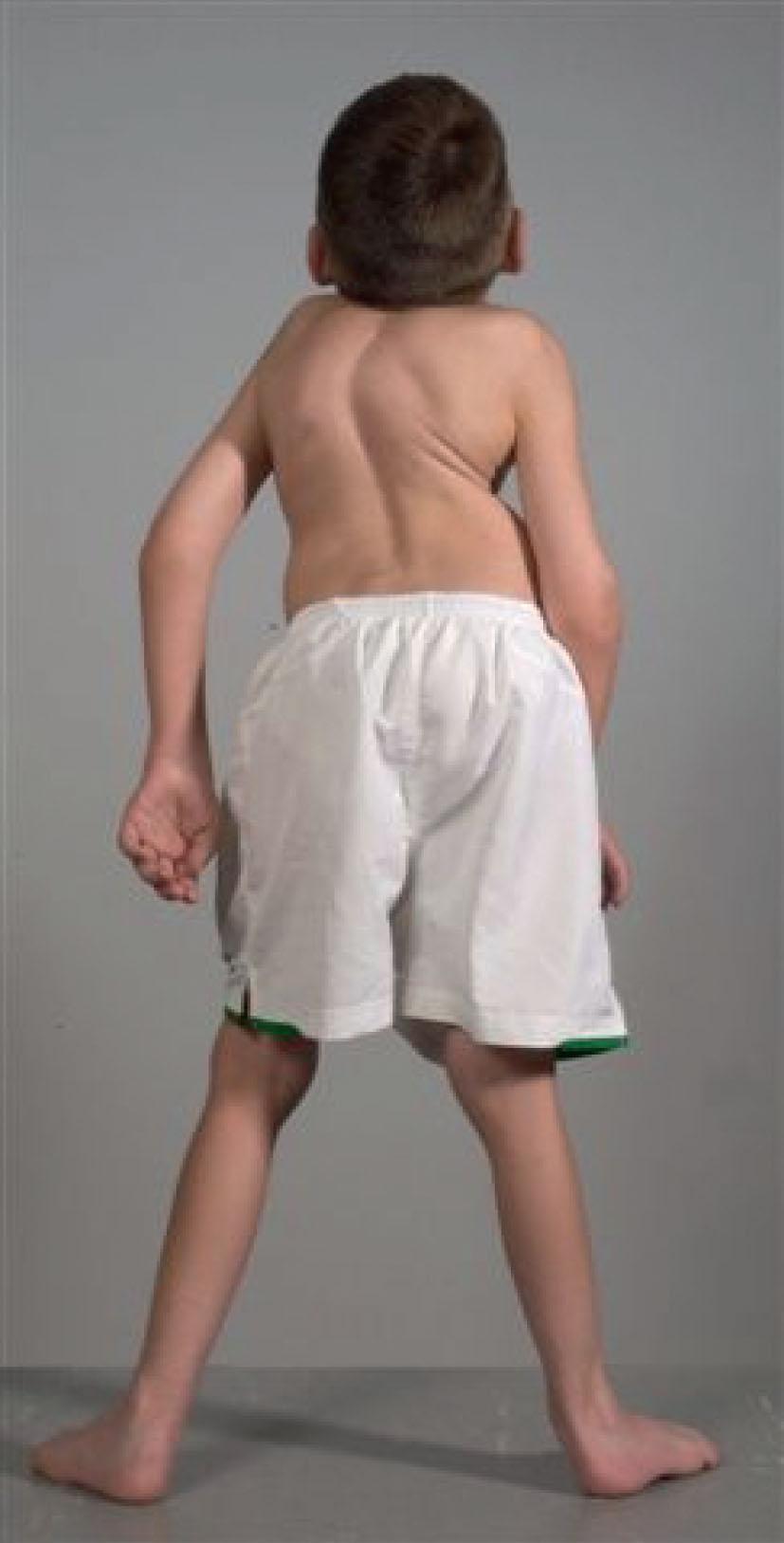
Corneal clouding is a characteristic feature of several of the MPS disorders (for example MPS I Hurler, Hurler–Scheie and Scheie, MPS IV Morquio, MPS VI Maroteaux–Lamy, and MPS VII Sly) ( Table 65.2 ), and may be present from infancy. Deposition of glycosaminoglycans (GAGs) within the corneal stroma leads to progressive diffuse corneal opacification, described as having a “ground-glass” appearance ( Fig. 65.2 ). Corneal opacification is milder in the less severely affected MPS I phenotype (Scheie) and is not a feature of MPS II (Hunter). Patients with MPS may have coarsening of facial features with pseudoexophthalmos ( Fig. 65.3 ), which can result in corneal exposure and subsequent vascularization.
| MPS type | Corneal clouding | Retinopathy | Optic nerve involvement |
|---|---|---|---|
| I (H, H/S, S) | Yes | Yes | Yes |
| II | No | Yes | Yes |
| III | Yes | Yes | Yes |
| IV | Yes | No | Yes |
| VI | Yes | No | Yes |
| VII | Yes | No | Yes |
| IX |
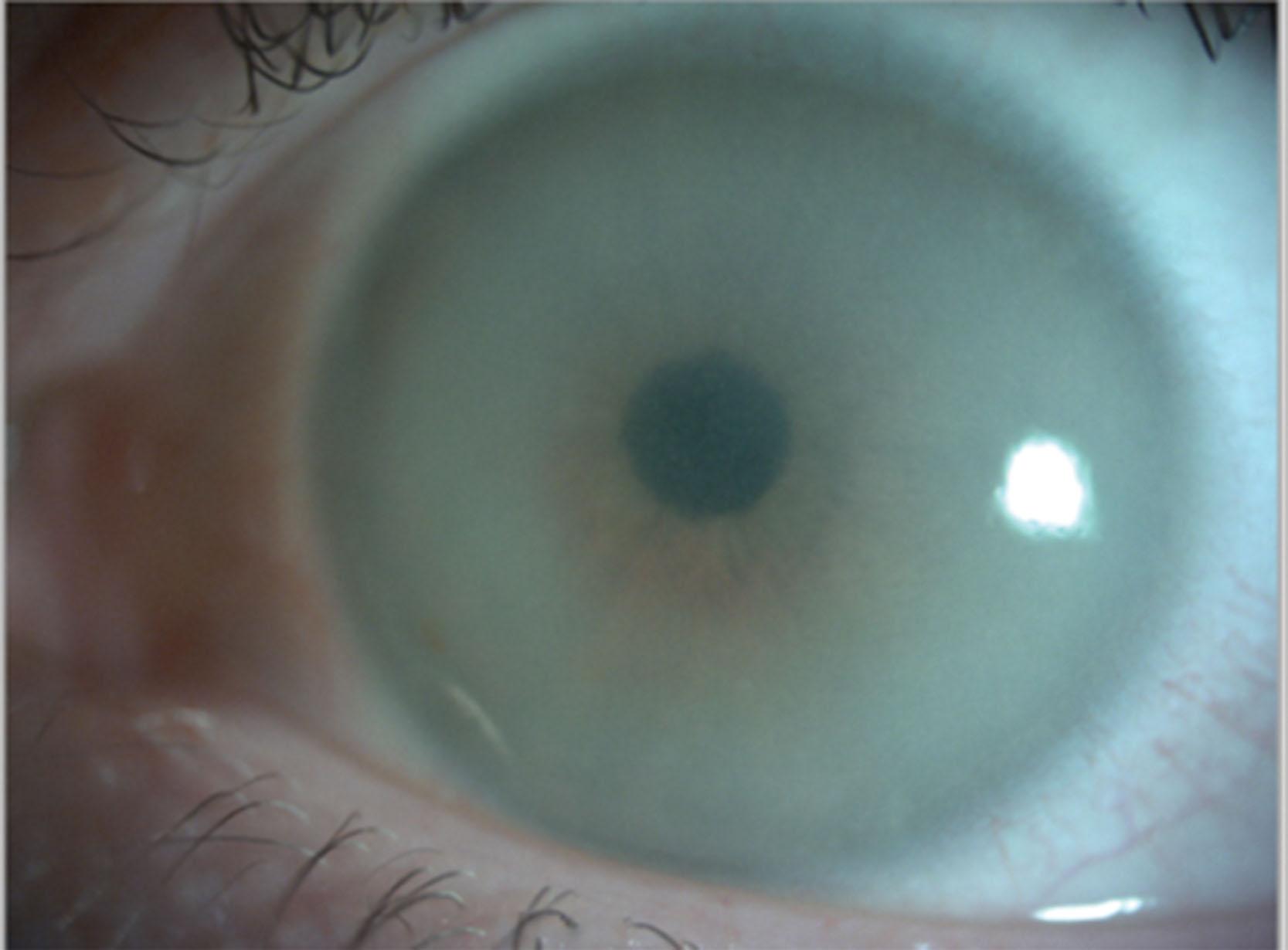
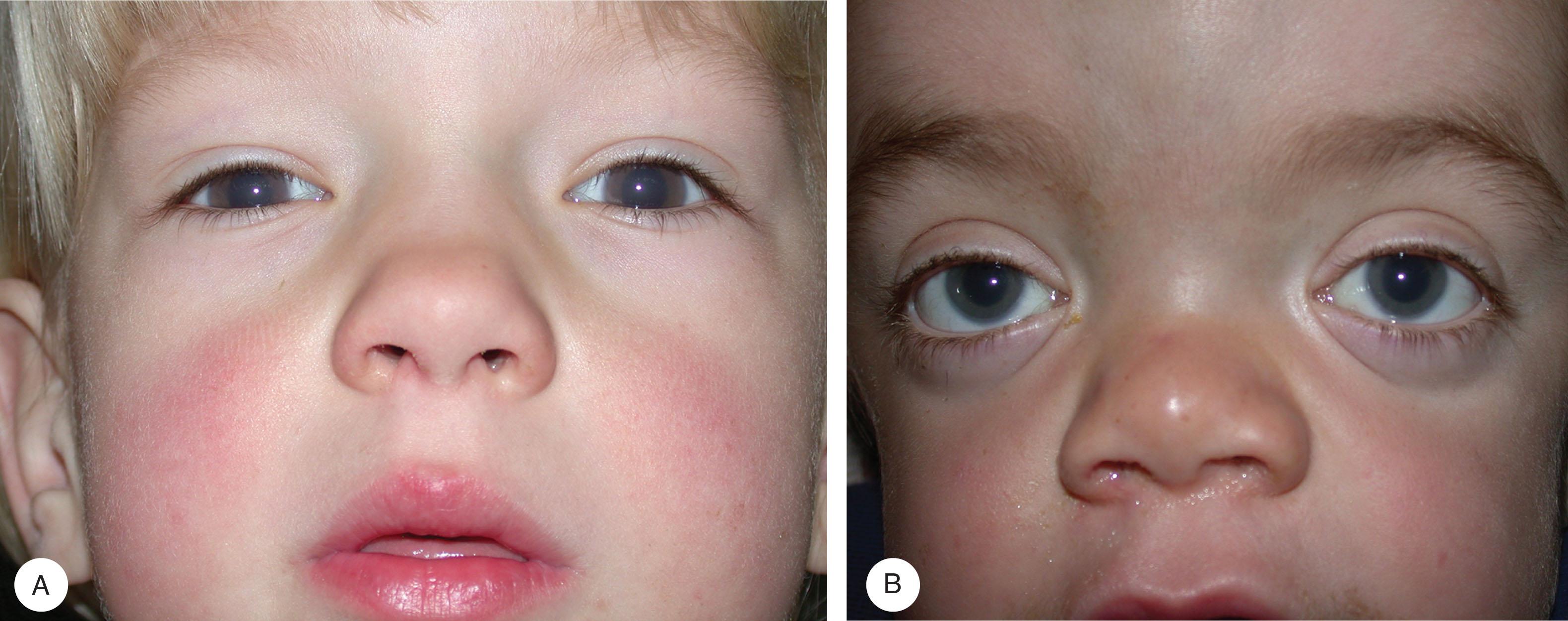
A patient with mild corneal clouding may be asymptomatic, but photophobia and reduced vision occur as the opacification worsens. GAG deposition can increase corneal thickness and affect corneal hysteresis, thus affecting the accuracy of intraocular pressure measurements. Corneal transplantation (penetrating keratoplasty or deep lamellar keratoplasty) ( Fig. 65.4 ) may result in improvement in vision when severe corneal opacification is the main cause of visual loss. However, an assessment of potential benefits of corneal transplantation must consider the presence of coexistent retinopathy and optic nerve dysfunction, as well as the significant anesthetic risks for patients with MPS.
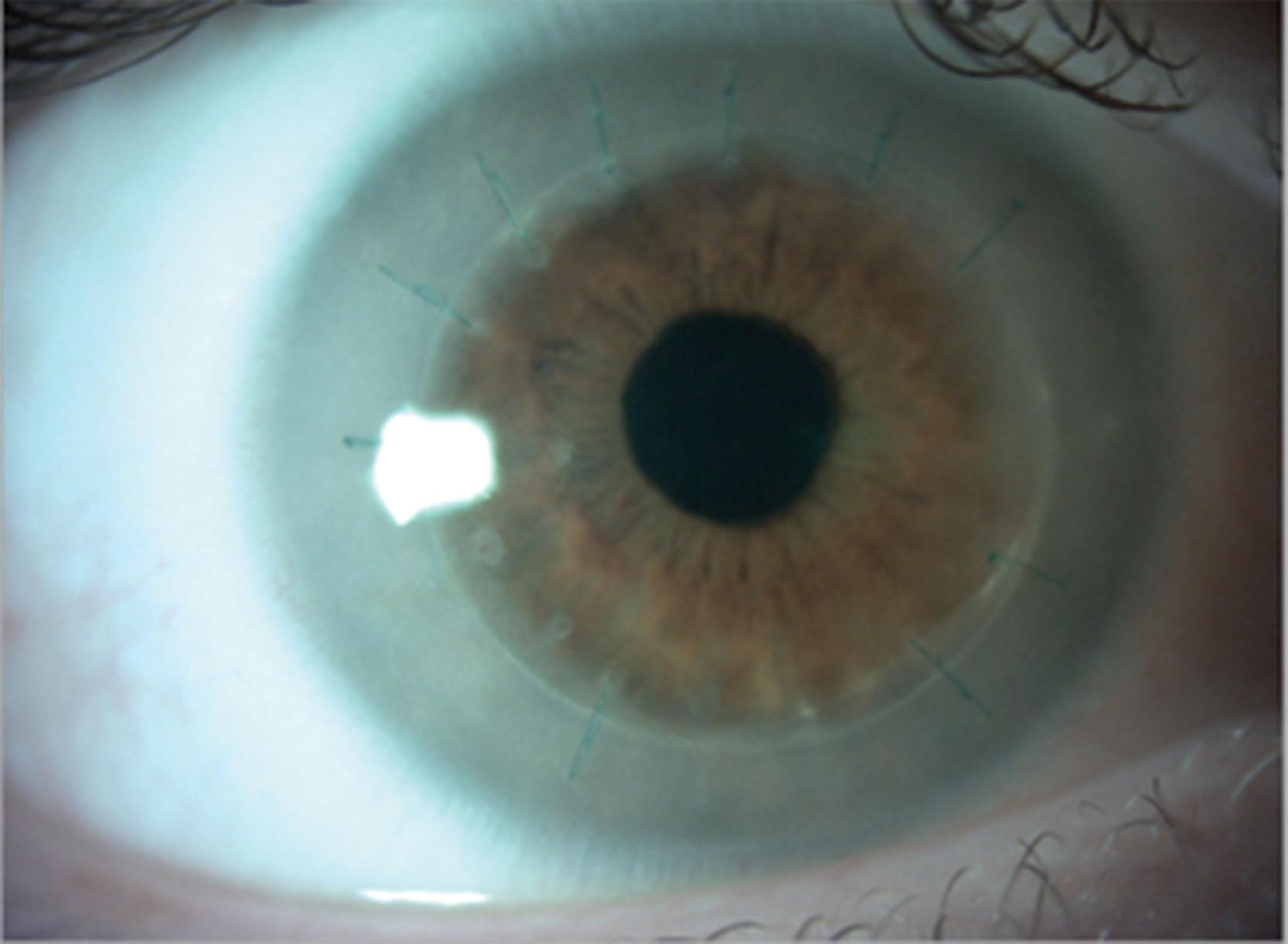
The majority of patients with MPS are hypermetropic due to changes in corneal refraction and reduced axial length. Strabismus and amblyopia are common.
Progressive retinopathy occurs in MPS I (Hurler, Hurler–Scheie, and Scheie), II (Hunter), and III (Sanfillipo) but is not usually a feature of MPS IV (Morquio) or VI (Maroteaux–Lamy) (see Table 65.2 ). The patient may experience night blindness and problems with peripheral vision, but this may go unnoticed due to the visual loss associated with corneal opacity. Signs of retinopathy include retinal pigment epithelial (RPE) atrophy and pigment clumping, arteriolar narrowing, optic disc pallor, and macula changes ( Fig. 65.5 ). Serial electroretinography (ERG) may show initial deterioration of rod-mediated responses, followed by involvement of cones.

The optic nerve often has a “full” appearance in patients with MPS, due to GAG deposition in the ganglion cells and within surrounding sclera ( Fig. 65.6A–B ). Patients with MPS may develop raised intracranial pressure and the resultant optic nerve compromise may lead to the acute onset of profound visual loss.
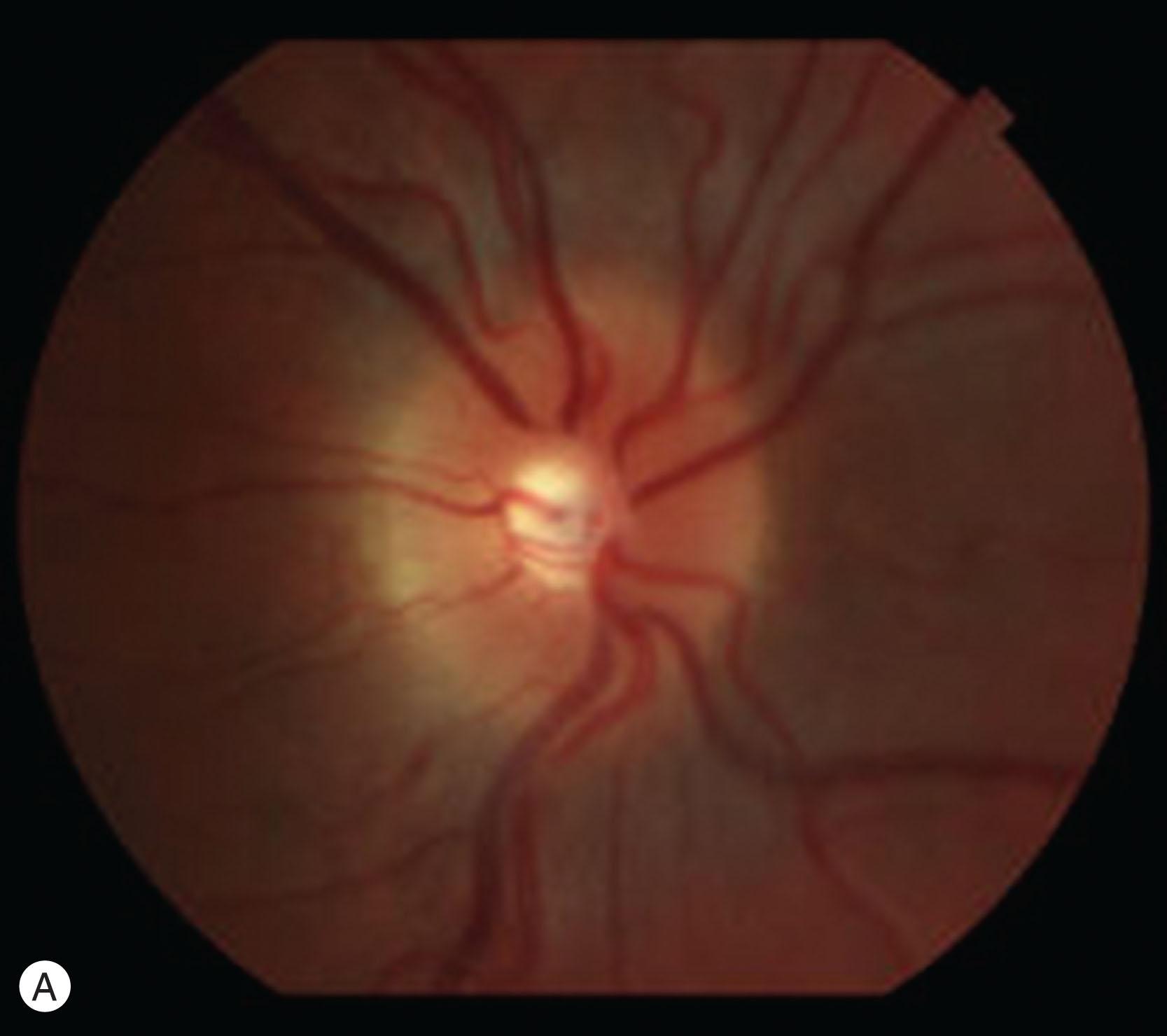
Glaucoma may arise in MPS due to accumulations of GAGs within the anterior segment resulting in a narrow angle, and within the trabecular cells leading to open angle glaucoma as a result of outflow obstruction. Difficulties in diagnosis and assessment of glaucoma arise in patients with MPS due to inaccuracy of intraocular pressure measurements, corneal clouding hampering assessment of the angle and disc, the presence of coexistent disc pathology, and difficulties with visual field assessment.
Punctate lens opacities may occur in MPS IV (Morquio).
Patients with α-mannosidosis have mild facial coarsening ![]() ( Fig. 65.7 ), skeletal abnormalities, a variable degree of learning difficulty, and deafness. A severe form (type I) results in early death from CNS manifestations and recurrent infections. In the attenuated form (type II), hearing loss and skeletal abnormalities become evident usually before the age of 10 years, following which ataxia and mental retardation become manifest. Ocular involvement includes corneal haze, lens opacities, retinal degeneration and optic atrophy, strabismus, nystagmus, and impaired smooth pursuit. HSCT may improve the neurologic outcome if undertaken early and ERT is licensed for the non-neurologic features.
( Fig. 65.7 ), skeletal abnormalities, a variable degree of learning difficulty, and deafness. A severe form (type I) results in early death from CNS manifestations and recurrent infections. In the attenuated form (type II), hearing loss and skeletal abnormalities become evident usually before the age of 10 years, following which ataxia and mental retardation become manifest. Ocular involvement includes corneal haze, lens opacities, retinal degeneration and optic atrophy, strabismus, nystagmus, and impaired smooth pursuit. HSCT may improve the neurologic outcome if undertaken early and ERT is licensed for the non-neurologic features.

Fucosidosis is a progressive neurodegenerative disease; clinical features include seizures, mild coarsening of the facies, skeletal dysplasia, and angiokeratomas. Affected children have conjunctival and retinal vascular tortuosity. Central “lobulated” corneal opacities may occur at an early age, and later a bull's eye maculopathy. HSCT in the early stages may improve the neurologic outcome.
Sialidosis is a result of α-neuraminidase deficiency; patients excrete sialyloligosaccharide in the urine.
Sialidosis type 1 or “cherry-red spot myoclonus syndrome” presents in late childhood with visual loss, myoclonic epilepsy, and ataxia. A cherry-red spot occurs, associated with thickening of the paracentral nerve fiber layer and hyperreflectivity of the ganglion cell layer on spectral optical coherence tomography (OCT), and macular hyperreflectivity with central hyporeflectivity on fundus autofluorescence ![]() ( Fig. 65.8 ). Sialidosis type 2 has an earlier onset with coarse facies, developmental delay, hepatomegaly, and dysostosis multiplex ( Fig. 65.9 ). In addition to cherry-red spots, patients with sialidoses may have nystagmus, punctate lens opacities, optic atrophy, corneal clouding, and visual field defects.
( Fig. 65.8 ). Sialidosis type 2 has an earlier onset with coarse facies, developmental delay, hepatomegaly, and dysostosis multiplex ( Fig. 65.9 ). In addition to cherry-red spots, patients with sialidoses may have nystagmus, punctate lens opacities, optic atrophy, corneal clouding, and visual field defects.
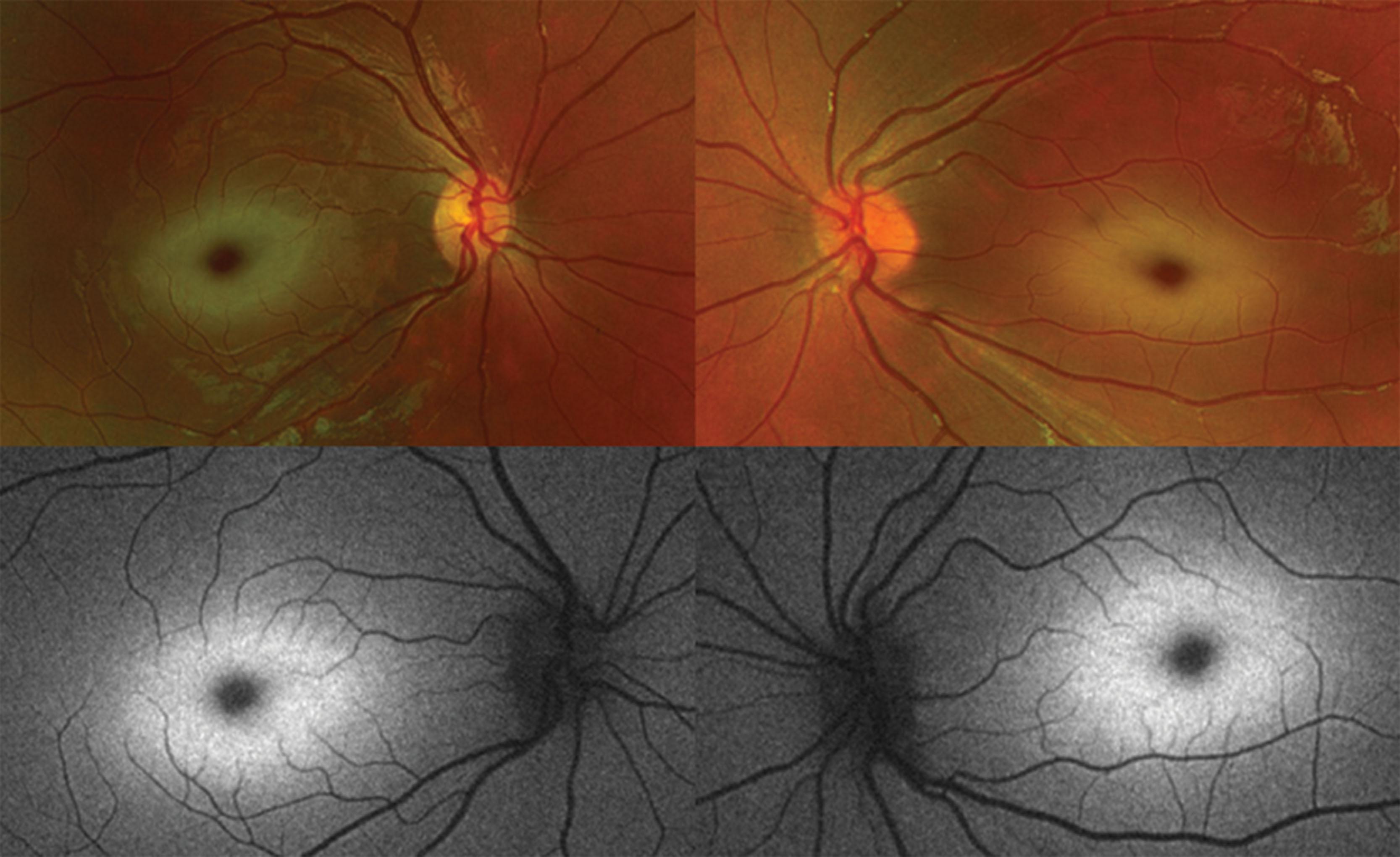
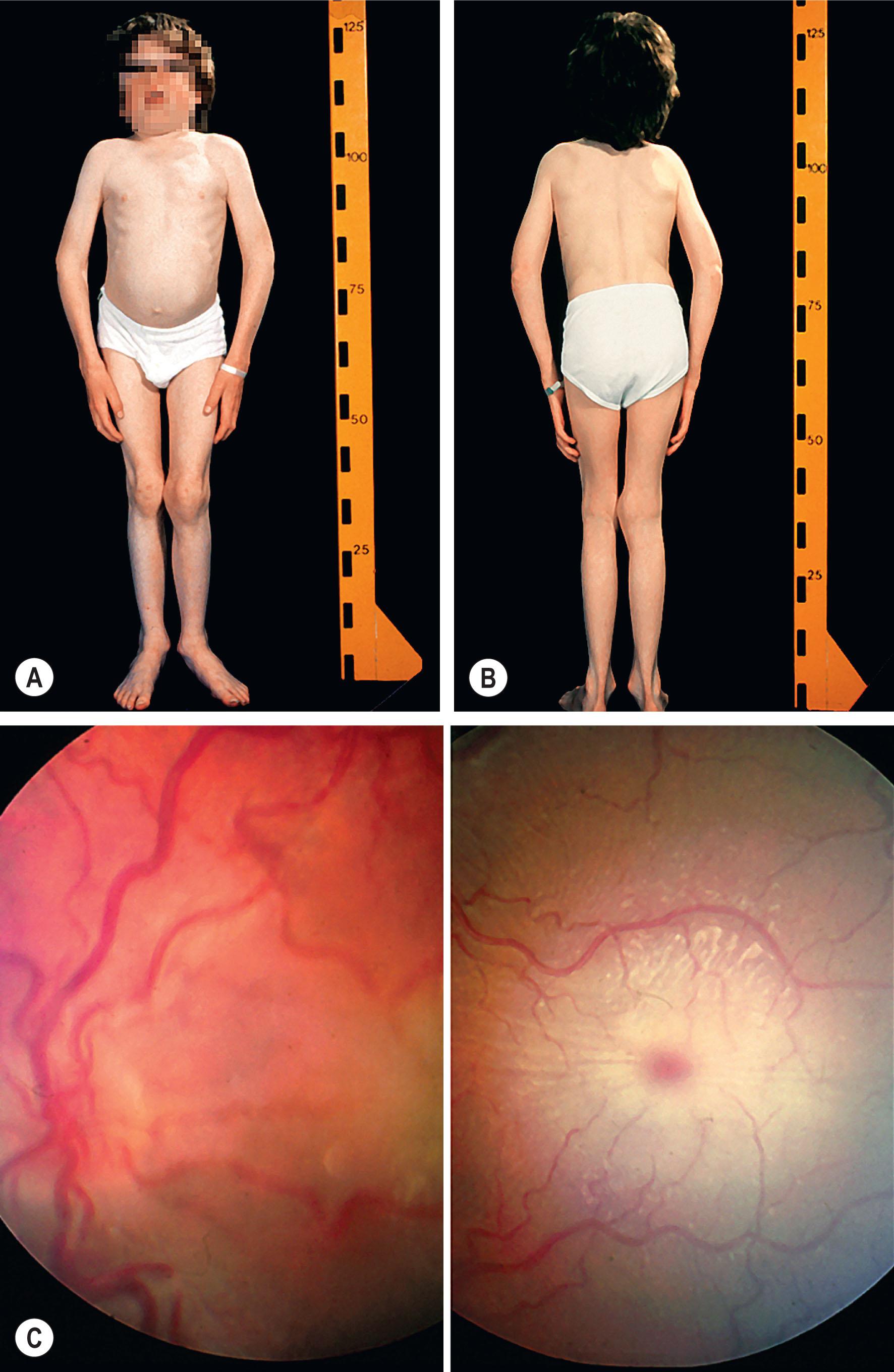
These result from a block in lysosomal efflux of sialic acid as a result of mutations in SLC17A5 , encoding the lysosomal protein sialin. They range in severity from infantile sialic acid storage disease (ISSD) with coarse facial features and fair complexion, severe developmental delay, hepatosplenomegaly and cardiomegaly, and death in early childhood, to Salla disease with slowly progressive mental retardation, ataxia, spasticity, and epilepsy. In ISSD, children may have albinoid fundi. In Salla disease, strabismus, nystagmus, and optic atrophy may occur.
Mucolipidosis (ML) II and III are autosomal recessive disorders caused by deficiency of N -acetylglucosamine-1-phosphotransferase, which phosphorylates carbohydrate residues on N -linked glycoproteins. This prevents lysosomal enzymes from entering the organelle.
ML II or “I cell” disease presents at an early age with neurodegeneration, joint stiffness, kyphoscoliosis, and severe MPS-like facial dysmorphism, including gum hypertrophy that may be present from birth ( Fig. 65.10 ). Death occurs in childhood. There is associated retinal degeneration and corneal clouding.

ML III is milder, with a slowly progressive course and survival to adulthood. Ophthalmic features include corneal clouding, hypermetropic astigmatism, optic disc swelling, retinal vascular tortuosity, and maculopathy. The ERG is normal.
ML IV is an autosomal recessive disorder resulting from mutations in the MCOLN1 gene, which encodes mucolipin-1. It is seen mainly in the Ashkenazi Jewish population. Clinical features include progressive mental retardation and hypotonia. ML IV patients have corneal epithelial haze, retinopathy with optic nerve pallor, vascular attenuation, and RPE change with electronegative ERG. Other ophthalmic features include strabismus, corneal erosion and episodic pain, cataract, and ptosis. Mild phenotypes have been described with only ocular manifestations of corneal clouding and retinopathy.
Sphingolipidoses are caused by abnormalities of catabolism of sphingolipids, which form an integral part of cerebral membranes. This group of disorders includes Fabry disease, Niemann–Pick disease, Gaucher disease, Krabbe disease, Tay–Sachs disease, and metachromic leukodystrophy. All show autosomal recessive inheritance except Fabry disease, which is X-linked. The sphingolipidoses have a wide range of presentations and severity.
Fabry disease is the most common LSD and is an X-linked recessive disease caused by a deficiency of α-galactosidase A. Males with Fabry disease usually present in late childhood or adolescence with pain in the extremities (acroparesthesia) provoked by exertion or change in temperature. Characteristic skin lesions (angiokeratoma corporis diffusum; Fig. 65.11 A ) are present, with dark red angiectases in the “bathing trunk area” (lower abdomen, buttocks, and scrotum). Later symptoms include a chronic progressive neuropathy ( Fig. 65.11B ), progressive renal dysfunction, heart disease (hypertrophic cardiomyopathy), and strokes. Heterozygous females may be asymptomatic or suffer the same problems as men, with a later onset and slower progression; the extent of manifestations is determined by X-chromosome inactivation. Fabry disease is treated with ERT, with intravenous infusions of recombinant α-galactosidase, agalsidase alfa, or agalsidase beta. Migalastat is a form of substrate reduction therapy licensed for adult patients with specific mutations.
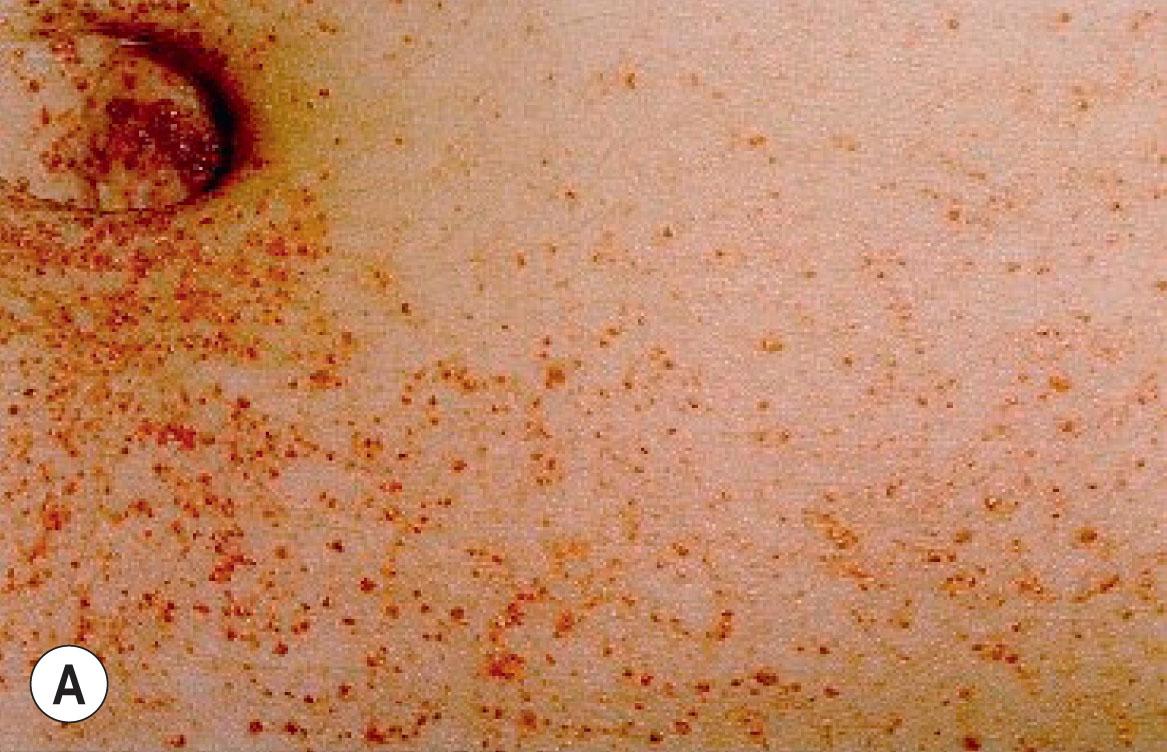
Ocular involvement occurs in approximately half of children with Fabry disease and the presence of cornea verticillata correlates with more severe disease. Corneal verticillata (whorl-like lines radiating from a single vortex; Fig. 65.11 C ) occur in both males and females with Fabry disease. They do not affect vision but may facilitate diagnosis. Corneal involvement also includes corneal haze and fine subepithelial brown lines. Conjunctival tortuosity and microaneurysms occur ( Fig. 65.11D ) and chronic chemosis may occur in affected adults. Characteristic lens opacities occur less commonly than corneal and vascular changes: a granular, wedge-shaped, subcapsular cataract, and lines of discrete opacities radiating from the posterior pole of the lens along the sutures ( Fig. 65.11E ). Retinal vascular tortuosity, particularly of veins, occurs in the second decade. The vessels become beaded, with sheathing, and may develop arteriovenous anastomoses and thromboses. Retinal vascular occlusion may be the initial manifestation of Fabry disease. Optic disc edema or myelinated nerve fibers may occur. Neuro-ophthalmological problems include nystagmus, third nerve palsy, and strabismus. Optic atrophy and internuclear ophthalmoplegia occur rarely. Visual field defects are common due to stroke.
GM1 gangliosidosis is caused by a deficiency of β-galactosidase resulting in the accumulation of GM1 gangliosides in the brain. Infantile GM1 gangliosidosis causes hypotonia from birth. By 6 months, patients have a coarse appearance with puffy skin, maxillary hypoplasia, hypertrophied gums, and macroglossia. Affected children have hepatosplenomegaly and dysostosis multiplex. Ocular motor apraxia (saccadic initiation failure), a cherry-red spot, optic atrophy, tortuous retinal vessels, retinal hemorrhages, and corneal clouding may occur. Rapid neurologic deterioration is usual, with seizures and swallowing difficulties and death by 2 years. Juvenile and adult forms occur, in which there is neurologic deterioration and dysostosis but no dysmorphism or ophthalmological abnormalities. There is no effective treatment.
The GM2 gangliosidoses include Tay–Sachs disease, caused by hexosaminidase A deficiency, most common in the Ashkenazi Jewish population, and Sandhoff disease caused by hexosaminidase A and B deficiency. These are clinically indistinguishable neurodegenerative disorders, with infantile, juvenile, and adult forms. A cherry-red spot is the typical eye finding ( Table 65.3 ). There is currently no effective treatment but a trial of gene therapy is in progress. The latest results for pyrimethamine showed no clinical benefit even in late-onset patients.
| Disease | Disease frequency of cherry-red spot |
|---|---|
| Niemann–Pick type A | Occasional |
| Niemann–Pick type B | Occasional |
| GM2 gangliosidosis (Tay–Sachs and Sandhoff) | Frequent |
| GM1 gangliosidosis, infantile | Occasional |
| Galactosialidosis | Frequent |
| Farber lipogranulomatosis | Occasional |
| Sialidosis type 1 | All |
| Sialidosis type 2 | Frequent |
| Metachromatic leukodystrophy | Occasional |
Most patients present in infancy with weakness and an exaggerated startle response, followed by loss of vision, feeding difficulties, seizures, and spasticity. Macrocephaly is common and death usually occurs by 2–4 years.
A cherry-red spot is apparent at an early stage, due to GM2 ganglioside accumulation in the retinal ganglion cells. As the ganglion cells die, the cherry-red spot fades and optic atrophy becomes apparent.
The juvenile and adult forms usually present with motor symptoms, such as ataxia, followed by dementia. Cherry-red spots are less common in the late-onset forms but adults may have saccadic abnormalities.
Metachromatic leukodystrophy usually presents at 1–2 years of age with deteriorating gait, spasticity, and loss of reflexes due to neuropathy. Later, there are speech and feeding problems. Optic atrophy leads to blindness and occasionally there is a cherry-red spot. Juvenile and adult-onset forms may present with deteriorating gait or with behavior problems. HSCT probably slows progression in the late-onset forms and gene therapy is being developed.
This is a severe neurodegenerative disorder with infantile, childhood, and late-onset forms. The early-onset form develops symptoms in the first few months with irritability and poor feeding, and progresses quickly to spasticity and a vegetative state. Visual impairment is common in the late stages due to optic atrophy or cortical blindness. HSCT can halt progression of the late-onset form and improve outcomes in the infantile form if undertaken within 30 days of birth.
Disorders in which there is storage of sphingomyelin are called Niemann–Pick disease. Types A and B are due to sphingomyelinase deficiency. Type C is a completely different condition, where ganglioside and sphingomyelin accumulation is due to a disorder of cholesterol transport within the cell.
Niemann–Pick type A, the severe part of the spectrum, is commoner in those of Ashkenazi Jewish descent. Patients present in infancy with failure to thrive and feeding difficulties. Hepatomegaly ( Fig. 65.12 ) is prominent and is more marked than splenomegaly, in contrast to Gaucher disease. Neurologic regression starts at 5–10 months with hypotonia. From around 18 months, there is loss of vision associated with a cherry-red spot and later optic atrophy. There may be a brown discoloration of the anterior lens capsule, but minimal corneal opacification. There is no treatment and most patients die by 3 years.
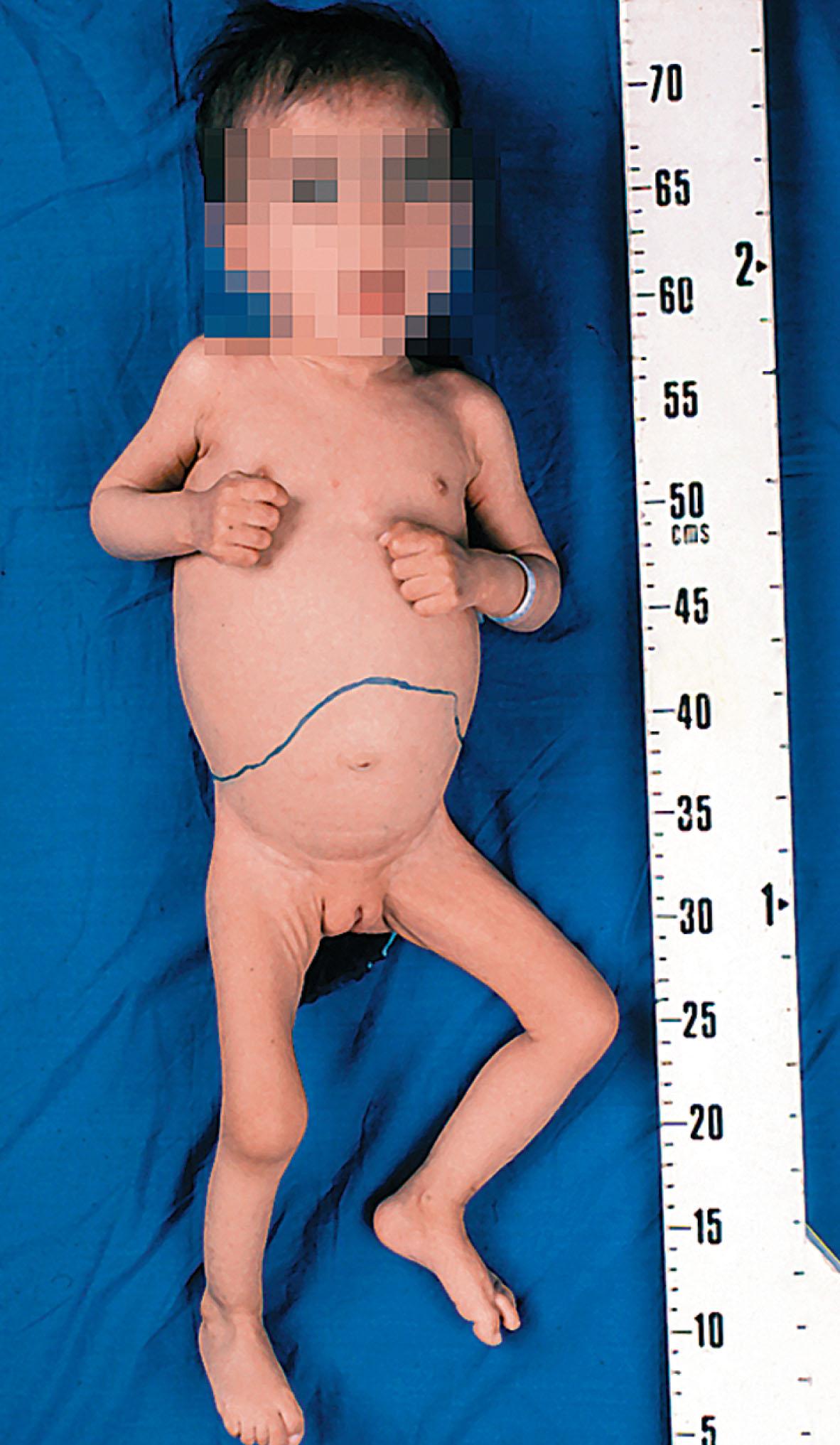
Niemann–Pick disease type B is less severe and presents later in childhood with hepatosplenomegaly. Usually there are no neurologic symptoms; some patients may have ataxia but are usually of normal intelligence. Massive splenic enlargement, cirrhosis of the liver, and pulmonary infiltration may occur. Eye abnormalities include periorbital fullness, macular granular deposits, and cherry-red spot. ERT is being developed for Niemann–Pick type B.
Niemann–Pick type C is due to impaired intracellular trafficking of cholesterol as a result of mutations in either the NPC1 or NPC2 genes. NPC is pan-ethnic.
Type C has variable presentations including neonatal liver disease, chronic splenomegaly, or neurologic deterioration in children or adults. Neurologic features include ataxia, cataplexy, seizures, psychoses, and dementia. A vertical supranuclear gaze palsy ![]() ( Fig. 65.13 ) is characteristic of this disorder and may be the presenting feature. There may be horizontal supranuclear eye movement defects or a supranuclear disorder of convergence. A faint cherry-red spot may be seen. Miglustat (an inhibitor of glucosylceramide synthase, which catalyzes the first step of glycosphingolipid synthesis) may slow progression of the neurologic disease.
( Fig. 65.13 ) is characteristic of this disorder and may be the presenting feature. There may be horizontal supranuclear eye movement defects or a supranuclear disorder of convergence. A faint cherry-red spot may be seen. Miglustat (an inhibitor of glucosylceramide synthase, which catalyzes the first step of glycosphingolipid synthesis) may slow progression of the neurologic disease.
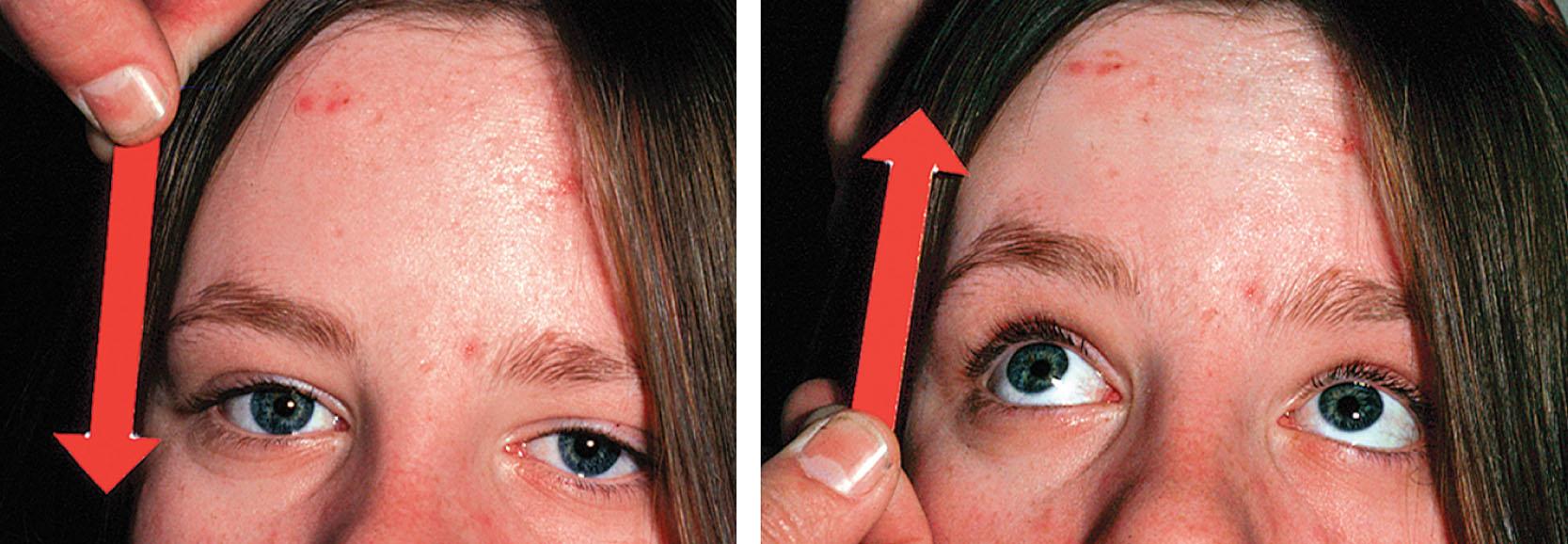
This autosomal recessive disease is characterized by the onset in infancy of multiple subcutaneous nodules, lymphadenopathy, a hoarse cry, and variable involvement of lung, heart, and liver. The course is variable, with death between 1 and 18 years. Severely affected children may have a cherry-red spot, nodular corneal opacity, or a pingueculum-like conjunctival lesion. There is no treatment.
Gaucher disease is an autosomal recessive disease that arises from mutations in the glucocerebrosidase ( GBA ) gene. Gaucher disease is classified according to severity and neurologic involvement into types 1, 2, and 3.
This is more common in people of Ashkenazi Jewish descent, and can present in children or adults with hepatosplenomegaly, anemia, thrombocytopenia, and leukopenia. There may be painful splenic and bony infarctions. Osteopenia may lead to pathological fractures and the distal ends of the femur may develop a typical Erlenmeyer's deformity (so named because it resembles a conical flask). Dark brown-yellow pingueculae occur in the nasal bulbar conjunctivae, which are characterized by numerous Gaucher cells on histologic examination. Macular change, choroidal neovascularization, and peripheral retinal vessel leakage occur. ERT with recombinant glucocerebrosidase is very effective, correcting the hematological abnormalities and organomegaly and ameliorating the bone disease. Substrate reduction therapy (miglustat and eligustat) may now be used for maintenance treatment in adults, as an oral alternative to ERT.
Become a Clinical Tree membership for Full access and enjoy Unlimited articles
If you are a member. Log in here